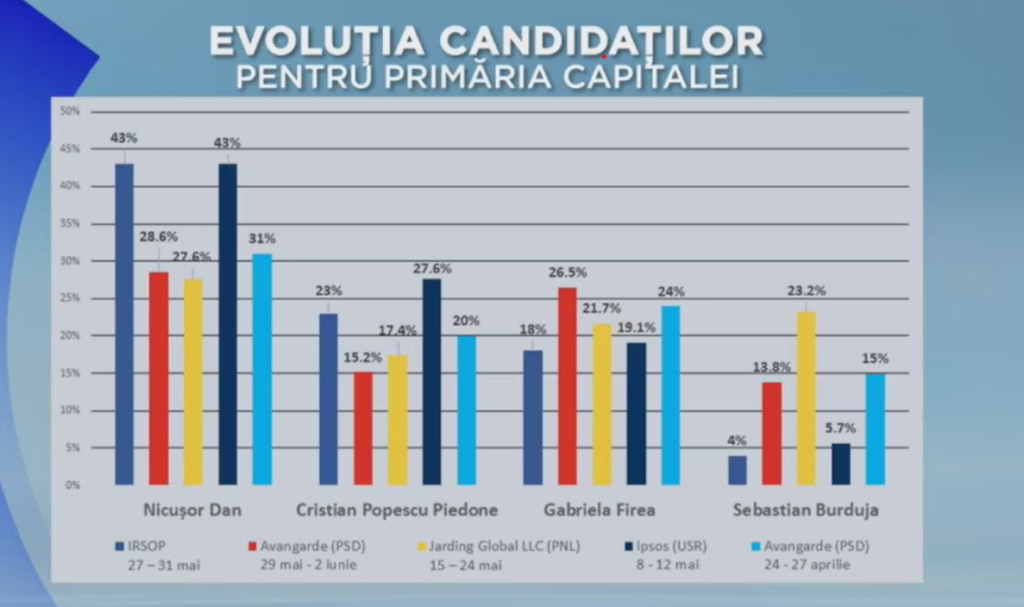If there is one certain victim after this electoral campaign, it is definitely the credibility of opinion polls, regardless of the outcome.
Throughout the campaign, at least in Bucharest, it has been a sort of roller-coaster of numbers. And it’s not just about the candidates’ developments throughout the campaign. It’s about fundamental differences in percentages and hierarchy.
Let's take the example of the last two surveys regarding the voting intention for the Capital's Mayor.
On June 2nd, Avangarde announced Nicușor Dan - 28.6%, Gabriela Firea - 26.5%, Cristian Popescu Piedone - 15.2%. Sebastian Burduja - 13.8%.
On June 3rd, IRSOP announced Nicușor Dan - 43%, Cristian Popescu Piedone - 23%, Gabriela Firea - 18%, Sebastian Burduja - 4%.

How can this be explained?
I asked sociologist Ionela Șufaru:
“When we read the data of polls in the press, we need to pay attention first and foremost to what exactly we are reading, more precisely: are the results published by the research agency that conducted the survey, is there the survey methodology, is the voting intention for candidates presented from the total sample, sub-sample of subjects who declared an option, sub-sample of subjects who expressed an option and are decided to vote/participate in the vote?
The poll data can indeed differ depending on the data collection method, the period of realization, but also the context around the elections, the type of election (parliamentary, presidential, local - mayor).”
The period of realization is important, especially when there is indecision regarding the candidates, so up to a point, at the beginning of the campaign, a greater fluctuation of the numbers would not be quite incomprehensible:
“Around the elections, over 60% of voters have their voting option outlined. Depending on how the pre-campaign period and the actual campaign period unfold, on the stability of nominating the candidates, especially in situations of nominal scrutiny (for the position of president, mayor, president of the county council), this proportion of voters who already have their voting option defined can be about 10-15% higher than the average of 60% mentioned earlier.
In conditions of instability, indecision regarding the nomination of candidates, information about candidates, the proportion of those who, in relatively short periods of time, about a month or 2-3 weeks, can change their voting options or decide not to vote, can vary significantly.
Therefore, the mentioned aspects have a direct influence on the period of conducting the survey, meaning that two surveys conducted with a difference of 2-3 weeks cannot be compared, the period of realization must be relatively similar,” explains Ionela Șufaru.
The data collection method is also crucial. “There are specific studies conducted to determine the differences obtained in surveys depending on the data collection method, face-to-face, CATI (telephone interviews), CAWI (online interviews). Such significant differences have been identified only through this simple aspect: when and how you interview the subject”.
The sampling method is crucial: “the power of opinion polls and their extrapolation character to the total reference populations lie precisely in using representative samples for the reference populations. Samples must mirror the reference populations in terms of age, gender, education, residential areas, socio-occupational status, etc.”
So, why do we have differences between surveys?
“Regarding the election for the Mayor of Bucharest, the instability of nominating candidates during the pre-campaign period has induced uncertainty among potential voters in the Capital regarding valid options even during the actual campaign period. I would say it still exists.
The survey data published these days do not have a comprehensive methodology, lack information regarding what I mentioned at the beginning: is the voting intention for candidates presented from the total sample, sub-sample of subjects who declared an option, sub-sample of subjects who expressed an option and are decided to vote/participate in the vote?”, says Ionela Șufaru.
Therefore, a mix of causes, some we could call objective and some related to the performance of the "surveyors".
It is impossible to believe that two surveys conducted at the same time, with fundamentally different results, far beyond the margin of error, such as Avangarde and IRSOP, can be correct at the same time. Obviously, one of the surveys is completely wrong. It is impossible for the one measuring Sebastian Burduja at 18% to be correct, and the one measuring him at 4%.
Surveys have also been wrong in other countries, but generally due to objective reasons.
Most often due to spirals of silence, people who hid their voting opinion because it was highly criticized in public discourse, whether it was about Brexit or Donald Trump in 2016.
We are not in such a situation except perhaps regarding AUR and SOS, who may have slightly more than what the polls measure in political voting, but cannot claim the Mayor of the Capital.
After the election, on the evening of June 9th at the latest, or June 10th, we will find out who was right and who was wrong. However, it is hard to believe that people will pay attention to who measured what, who communicated what figures. What will probably remain is the conviction that no one is trustworthy, that everyone is either unprofessional or corrupt.

